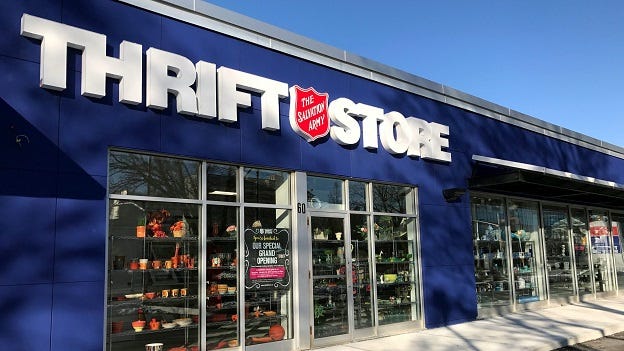Part 1: How Thrift and Consignment Stores Started The Resale Revolution
Let’s get into it.
You can't talk about the secondhand industry without talking about the original secondhand business models: thrift and consignment stores. These classic resale businesses make up the backbone of the secondhand industry, both originally and still today.
A Brief History
These traditional models for spreading used clothing around had been the common provider of secondhand fashion until the origin of online resale which was born in the mid 90s, just a few years after the internet was made public.
In the late 19th century, as urban areas were becoming more populated and living spaces were getting smaller, the need for better waste management and offloading possessions was becoming apparent. Thanks to the Industrial Revolution and mass production which made clothes more easily available and affordable, people weren't as concerned about holding onto their clothes as long. Thus was born the start of the secondhand business model we recognize today which took the form of pushcarts traveling to households to collect unwanted clothes for resale.
Religious organizations saw clothing resale as an opportunity to make money in support of charity efforts. They used these models to hire people to collect, repair, and sell the clothing mostly to others in need. Used clothing was stigmatized at the time and thrift stores were a feel-good place for middle and upper class individuals to donate to, not shop from. By the 1930s, Goodwill and Salvation Army established quite the presence, in high demand during the Great Depression and then abundantly supplied in the period of prosperity after WWII. Consignment stores arose in the 1950s out of the desire to shop high-end clothes at a more affordable price.
In the last couple decades, secondhand has shed its stigma and it's now a business model that many shop from in its various new forms. But first, let's dig into how thrift and consignment stores actually work.

The Thrift Business Model
Thrift stores, also called charity shops or op-shops (opportunity shops), rely on community donations to supply their inventory. Many of these stores operate as non-profits and have charitable services or social initiatives incorporated into their model. However, there are also many for-profit thrift stores that operate similarly. The business model is fairly straightforward: community members donate goods, those items are sorted according to condition and type, and suitable clothes are put out on the selling floor.
The Consignment Business Model
A consignment model differs from a thrift model in how the clothing is sourced from the community. With consignment, the original item owner is compensated for the clothing they bring to the store. Consignment stores can either sort and pay for the goods off of the owner up front, only taking what they deem to have market value at the time, or some consignment stores will pay the item owner a percentage of the income after the item is sold. Either way, when a customer brings in clothing to a consignment store, the shop will only accept what they expect to sell. Basically, consignment stores are pickier and, as a shopper, you can expect their collection to be more curated and priced accordingly for their hand-picked selections. For this reason, consignment stores will have a more targeted approach, specializing in certain styles, clothing types, or demographics, whereas, thrift stores will take anything and sell it if they can.
Major Players
While there are several corporate thrift and consignment chains, there are also many local thrift stores that cater to their specific communities. When it comes to major industry players, Goodwill and the Salvation Army are some of the original and biggest businesses in the space that operate as non-profits. Among for-profit thrift stores is Savers (also called Value Village) and America's Thrift Store. Popular consignment shops include Plato's Closet, Buffalo Exchange, and Crossroads Trading. Lastly, ThredUP is a multifaceted secondhand business that includes an online-based consignment service that has streamlined both the closet clean out process and online thrifting for many.
Industry Role
These types of businesses established the secondhand industry and largely still dominate and feed the growing industry. While the traditional thrift model hasn't evolved much, its popularity has validated the idea that there's a legitimate, lucrative market for secondhand. People are more receptive to secondhand shopping than ever before, with 75% of consumers reporting having shopped secondhand or being open to it.
The presence alone of thrift stores has enabled other types of resale and clothing disposal businesses to emerge. Resellers use thrift stores as an inventory source. Stylists turn to thrift and consignment stores to find unique, more affordable looks for their clients. Excess thrift inventory is sent to recycling centers to attempt to give clothing yet another life.
The secondhand industry would not be what it is today with all of its growth, diversity, and innovation if thrift and consignment stores didn't pave the way.

Opportunities & Challenges
One of the biggest challenges faced by traditional secondhand stores, specifically thrift stores, is the overwhelming amount of inventory they receive. Many thrift stores are only selling 10-20% of their inventory. The rest gets sent to the sorting and recycling centers mentioned above. The sheer volume of clothing these businesses have to process and sort through adds to the workforce needed and the cost of doing business.
One of the great things about the expansion of the secondhand industry and new players entering the resale game is that it helps alleviate the inventory burden. Instead of thrift and consignment models being the only option for getting rid of clothes, customers can use newer additions to the industry like resale marketplaces to rehome their clothing. Plus, the increased interest in secondhand and the rise of the reseller helps to clear out that inventory, too. There is more than enough secondhand to go around and endless opportunity for businesses to re-imagine how those clothes can be used rather than be sent to landfill.
So join us over the coming weeks as we dig further into how the industry has diversified and been disrupted to become the secondhand space that it is today! Next up: resale marketplaces!



